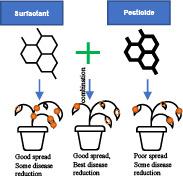当前位置:
X-MOL 学术
›
Plant Pathol.
›
论文详情
Our official English website, www.x-mol.net, welcomes your
feedback! (Note: you will need to create a separate account there.)
Surfactants in plant disease management: A brief review and case studies
Plant Pathology ( IF 2.3 ) Pub Date : 2020-11-20 , DOI: 10.1111/ppa.13318 Mustafa O. Jibrin 1, 2 , Qingchun Liu 1 , Jeffrey B. Jones 3 , Shouan Zhang 1
Plant Pathology ( IF 2.3 ) Pub Date : 2020-11-20 , DOI: 10.1111/ppa.13318 Mustafa O. Jibrin 1, 2 , Qingchun Liu 1 , Jeffrey B. Jones 3 , Shouan Zhang 1
Affiliation

|
In plant disease management, surfactants are generally used in combination with pesticides to facilitate delivery of the pesticide chemicals to the target sites in plants, vectors, or pathogens. Their intended use is rarely for direct effect on plant pathogens. However, trends in recent studies have revealed an appreciable increase in their use for direct management of plant diseases. In this paper, we briefly review the progress made in the use of surfactants for disease management, as adjuvants and when applied for direct effect. We carried out experiments to evaluate the effect of selected synthetic surfactants (Cohere, Kinetic, Silwet‐77, and Induce) on powdery mildew in squash and bacterial spot in tomato. Results from this study showed that the effect of surfactants on these pathogens is dependent on the type of plant pathogen or disease. All tested surfactants exhibited in vitro bactericidal activity against Xanthomonas perforans, a causal pathogen of bacterial spot of tomato. In the greenhouse, Cohere significantly reduced disease severity of powdery mildew in squash compared to the untreated control. Cohere also showed promise in field trials against bacterial spot of tomato, but the other surfactants tested promoted this disease. Our studies demonstrate the importance of evaluating surfactants for their use in management of plant diseases both for direct effect and as adjuvants in tank mix.
中文翻译:

表面活性剂在植物病害管理中的简要回顾和案例研究
在植物病害管理中,表面活性剂通常与农药结合使用,以促进农药化学物质向植物,载体或病原体的目标部位的传递。它们的预期用途很少直接影响植物病原体。但是,最近的研究趋势表明,将其用于直接处理植物病害的使用显着增加。在本文中,我们简要回顾了将表面活性剂用于疾病管理,作为佐剂以及直接应用时的进展。我们进行了实验,以评估选定的合成表面活性剂(Cohere,Kinetic,Silwet-77和Induce)对南瓜中白粉病和番茄细菌斑的影响。这项研究的结果表明,表面活性剂对这些病原体的作用取决于植物病原体或疾病的类型。黄单胞菌(Xanthomonas perforans),番茄细菌斑的病原体。与未经处理的对照相比,在温室中,Cohere大大降低了南瓜白粉病的病害严重程度。Cohere在针对番茄细菌斑的田间试验中也显示出了希望,但是测试的其他表面活性剂促进了这种疾病。我们的研究表明,评估表面活性剂在控制植物疾病中的直接作用和罐混助剂的重要性。
更新日期:2020-11-20
中文翻译:

表面活性剂在植物病害管理中的简要回顾和案例研究
在植物病害管理中,表面活性剂通常与农药结合使用,以促进农药化学物质向植物,载体或病原体的目标部位的传递。它们的预期用途很少直接影响植物病原体。但是,最近的研究趋势表明,将其用于直接处理植物病害的使用显着增加。在本文中,我们简要回顾了将表面活性剂用于疾病管理,作为佐剂以及直接应用时的进展。我们进行了实验,以评估选定的合成表面活性剂(Cohere,Kinetic,Silwet-77和Induce)对南瓜中白粉病和番茄细菌斑的影响。这项研究的结果表明,表面活性剂对这些病原体的作用取决于植物病原体或疾病的类型。黄单胞菌(Xanthomonas perforans),番茄细菌斑的病原体。与未经处理的对照相比,在温室中,Cohere大大降低了南瓜白粉病的病害严重程度。Cohere在针对番茄细菌斑的田间试验中也显示出了希望,但是测试的其他表面活性剂促进了这种疾病。我们的研究表明,评估表面活性剂在控制植物疾病中的直接作用和罐混助剂的重要性。











































 京公网安备 11010802027423号
京公网安备 11010802027423号